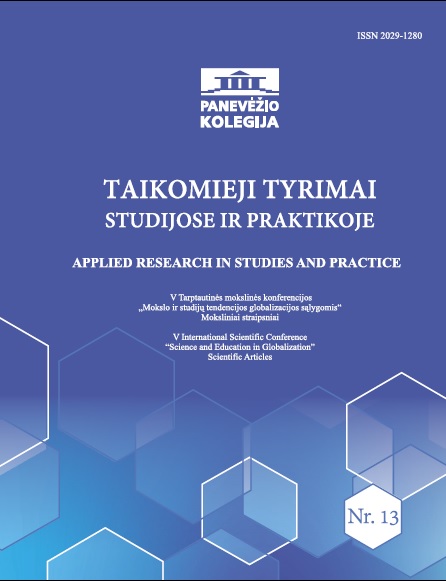EVALUATION OF THE INFLUENCE OF MARITIME TRANSPORT ON ECONOMICS CHANGES AT THE EASTERN COAST OF THE BALTIC SEA
EVALUATION OF THE INFLUENCE OF MARITIME TRANSPORT ON ECONOMICS CHANGES AT THE EASTERN COAST OF THE BALTIC SEA
Author(s): Elena Valionienė, Gabrielė Jankauskaitė, Kristina StatkutėSubject(s): Economy
Published by: Panevėžio kolegija
Keywords: maritime transport; hinterland transport; impact on economics;
Summary/Abstract: As the scientific researchers found out the transportation sector has a strong impact for the economic and regional development, and influence the national integration to the global world economy. The higher turnover of handled cargos and transported passengers need for more infrastructure, provisions and associated logistic services, which would create the higher degree of benefit to the national economy. Sea ports are also important for the support of economic activities in the region because they become as a crucial link between sea and land transport. Exportation of production and importation of raw material are targets of global modern industry and it is required for the cheap and effective transportation system. The combined way of cargo transportation through the seaports is one of the possible and attractive solutions for whole global industry. On the base of made researches the transport sector, including maritime transport, is big part of the country's economy, providing up to 80% of global trade turnover. Sea port operations increasing the cargo flows in the whole transport system, promote the growing of investments to infrastructure, encourage creation of new work places, and generate fees and charges which are limited to the national budget. Distribution services at the seaports influence the increasing of the seaport’s and country’s economy’s competitiveness in region. Therefore, the seaports and whole transport sector are dependent on the governmental transport strategies, tax policies and other changes in politics formation procedures. So, the strong relationship between maritime transport sector and national economy exist and the importance of the research could be justified by the importance of these relationships’ analysis at the eastern Baltic sea region because the Lithuania, Latvia and Estonia maritime sectors have strong competitiveness relation geographically based on the realization of connections between the Western European and Asian countries as the transport corridor.Based on these assumptions the object of research is the maritime transport sector on the coast of the eastern Baltic sea. The aim of the research is to determine the main factors of maritime transport activities which could make an impact on the national economies at the Eastern Baltic Sea region. Objectives of the research are: to describe the main indicators characterizing the situation of national economies; to describe Estonian, Latvian and Lithuanian maritime cargo flows from the viewpoint of hinterland services; to assess the influence of Estonian, Latvian and Lithuanian maritime freight rates on the national economies of this region. The empiric research is based on the quantitative methods such as statistical analysis of official data, forecasting tendencies of changes, correlation analysis, analysis of possible situations and scenarios. The methodology is justified on the researches of maritime transport field, presented in international conferences and seminars, also an analysis of a wide range of scientific literature sources and researches were applied for the justification of research methodology.The main research scientific directions were performed by assumptions, that during last 10 years period, total cargo flow at the seaports of the eastern Baltic sea were almost stable and main changes were fixed only in freight rates of different seaports. It means that in the region intensive competition exists and each maritime sector has potentially prevent the negative changes in freight rates by increasing the complexity of associated logistical services. As cargo flows’ dynamics showed, the most intensive maritime cargo throughput was fixed at Lithuanian maritime business, where cargo freight indicators averagely annual increased by 1.82 million tons per year. Latvian maritime freight rates grew averagely annually by 1.56 million tons, Estonian freight rates decreasing averagely by 0,21million tons. But it is important to note, that the summarized freight rates in Lithuanian maritime sector is smaller than it is in Latvian maritime transport segment, but freight rates here have most intensive growing tendency. The results of interrelations between maritime sectors and national economy found out that Estonian maritime cargo flows and national economy are almost, but Latvian maritime cargo flows are sensitive for each change in expenditures related with export and import prices. Lithuanian freight rates are dependent on increasing of taxes; Latvian and Lithuanian maritime sectors are more dependent on imported cargo flows, but Lithuanian maritime business sector is more stable because works with geographically established and optimized cargo flows. From the other side, the optimal business conditions is required from the law regulation and transport policy implementation. On the base of these results the assumption was made that these results could be dependent on the geographical location and weather conditions, investments to infrastructure, accessibility of international railways and truck ways, also the operational effectiveness of stevedoring operations. And the assumption were formulated, that effective investments to infrastructure is possible tool to increase the planned positive impact on national economy and should create preconditions for special symbiotic cycle related with the effective investments to infrastructure and economic benefits.
Journal: Taikomieji tyrimai studijose ir praktikoje
- Issue Year: 13/2017
- Issue No: 1
- Page Range: 55-64
- Page Count: 10
- Language: English

